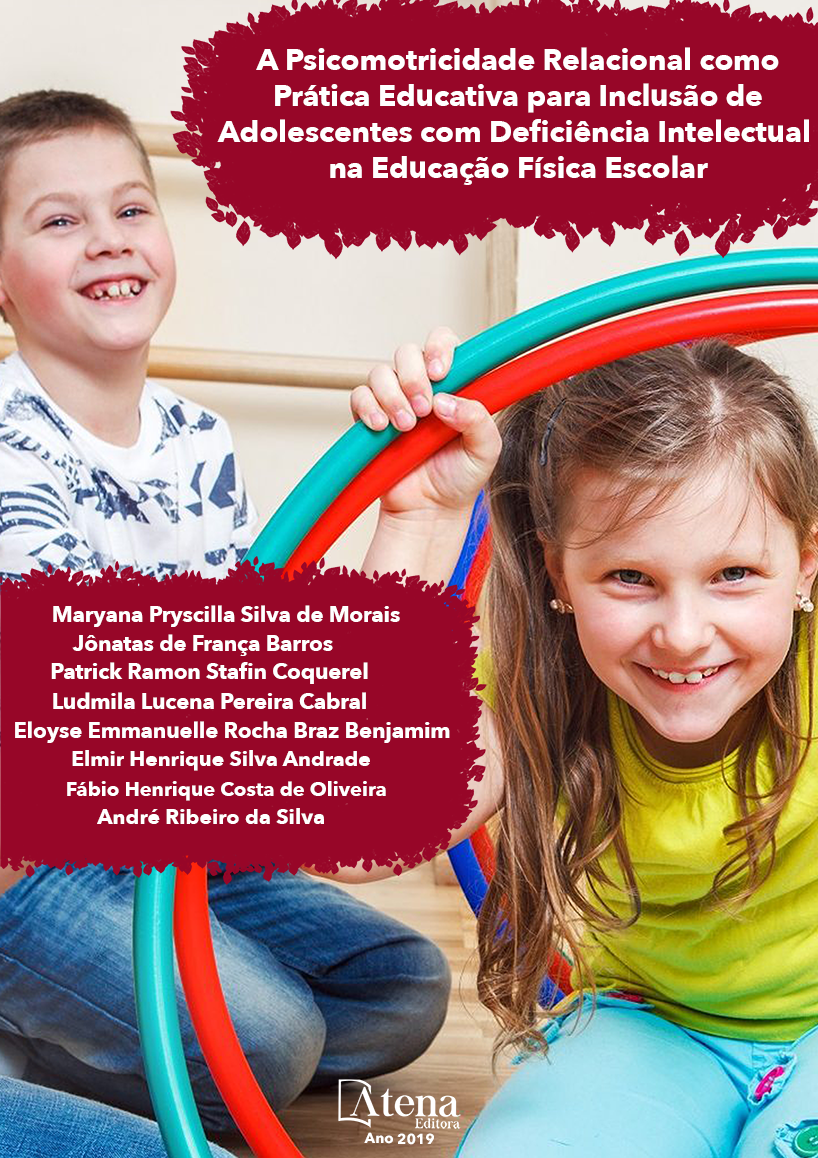
A PSICOMOTRICIDADE RELACIONAL COMO PRÁTICA EDUCATIVA PARA INCLUSAO DE ADOLESCENTES COM DEFICIÊNCIA INTELECTUAL NA EDUCAÇÃO FÍSICA ESCOLAR
ntrodução: A Psicomotricidade Relacional (PR) foi desenvolvida na década 70 do
século XX, pelos professores de educação física franceses André Lapierre e Bernard
Aucouturier. É uma prática educativa que utiliza o jogo simbólico na ação do brincar
espontâneo em prol do desenvolvimento integral e da autonomia do sujeito. Objetivo:
Analisar o processo de inclusão de pessoas com deficiência intelectual na educação
física escolar, por intermédio da prática educativa da PR. Metodologia: Trata-se
de uma pesquisa de cunho “participante” de forma não probabilística, e um tipo de
amostragem por conveniência. As coletas de dados foram realizadas com um grupo
de 36 estudantes do 7º ano do ensino fundamental II de uma escola pública municipal
de Natal-RN, e tendo 3 estudantes com deficiência intelectual. Os instrumentos de
coletas desta pesquisa, foram 1 máquina fotográfica digital SONY Cyber-shot, 2
filmadoras digitais NAVCITY esportiva NG-100, anamnese de Sampaio (2010), os
relatórios espontâneos dos discentes, os relatórios espontâneos e reflexivos dos
professores. Foram realizadas 8 aulas de educação física com o jogo simbólico da
Psicomotricidade Relacional, uma vez por semana, durante um bimestre letivo. Foi
realizada uma análise qualitativa dos dados, incluindo codificação, decodificação,
interpretação e construção do referencial teórico. Resultados: Nas oito aulas o
processo inclusivo aconteceu gradualmente de forma espontânea não diretiva, ilustrado
nas fotografias e audiovisuais. Os alunos puderam perceber a inclusão pedagógica
e/ou social e vivenciá-la. Nos relatórios espontâneos e reflexivos dos professores,
a inclusão pedagógica e/ou social aconteceu livremente. No que tange os relatórios
espontâneos dos alunos, foram expressos os conteúdos vividos pelos estudantes com
deficiência intelectual na relação com os demais colegas e professores. Os alunos
com deficiência intelectual expressaram a relação com o outro e com os objetos por
meio do grafismo. Conclusão: A abordagem da Psicomotricidade Relacional como
vivência da prática pedagógica educativa nas aulas de educação física possibilitou a
inclusão dos estudantes com deficiência intelectual, propiciando a eles à aceitação das
diferenças corporais, intelectuais, morais, emocionais e a compreensão da relevância
do processo inclusivo.
A PSICOMOTRICIDADE RELACIONAL COMO PRÁTICA EDUCATIVA PARA INCLUSAO DE ADOLESCENTES COM DEFICIÊNCIA INTELECTUAL NA EDUCAÇÃO FÍSICA ESCOLAR
-
DOI: 10.22533/at.ed.211190908
-
Palavras-chave: educação física escolar, psicomotricidade relacional, inclusão, deficiência intelectual.
-
Keywords: school physical education, relational psychomotricity, inclusion, intellectual disability.
-
Abstract:
Relational Psychomotricity (PR) was developed in the 1970s by
French physical education teachers André Lapierre and Bernard Aucouturier. It is an
educational practice that uses the symbolic game in the action of spontaneous play for
the integral development and the autonomy of the subject. Objective: To analyze the
process of inclusion of people with intellectual disabilities in school physical education,
through the PR educational practice. Methodology: This is a “participant” research in
a non-probabilistic way, and a kind of sampling for convenience. Data were collected
with a group of 36 students from the 7th grade of elementary school II of a municipal
public school in Natal-RN, and having 3 students with intellectual disabilities. The
collection instruments of this research were 1 SONY Cyber-shot digital camera, 2 NG-
100 sports digital camcorders, Sampaio anamnesis (2010), the spontaneous reports
of the students, the spontaneous and reflexive reports of the teachers. Eight physical
education classes were held with the symbolic game of Relational Psychomotricity,
once a week, during a two-month period. A qualitative analysis of the data was
performed, including coding, decoding, interpretation and construction of the theoretical
framework. Results: In the eight classes the inclusive process happened gradually
in a spontaneous non-directive form, illustrated in the photographs and audiovisual.
The students were able to perceive the pedagogical and / or social inclusion and to
experience it. In the spontaneous and reflective reports of teachers, pedagogical and
/ or social inclusion occurred freely. Regarding the students’ spontaneous reports, the
contents of the students with intellectual disabilities were expressed in the relationship
with other colleagues and teachers. Students with intellectual disabilities expressed
their relationship with each other and with objects through graphics. Conclusion: The
approach of Relational Psychomotricity as an experience of educational pedagogical
practice in physical education classes allowed the inclusion of students with intellectual
disabilities, providing them with the acceptance of the corporal, intellectual, moral and
emotional differences and the comprehension of the relevance of the inclusive process.
-
Número de páginas: 15
- Maryana Pryscilla Silva de Morais
- Jônatas de França Barros
- Patrick Ramon Stafin Coquerel
- Ludmila Lucena Pereira Cabral
- Eloyse Emmanuelle Rocha Braz Benjamim
- Elmir Henrique Silva Andrade
- Fábio Henrique Costa de Oliveira
- André Ribeiro da Silva


